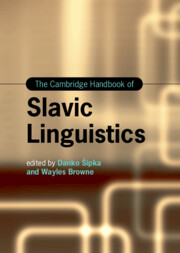Book contents
- The Cambridge Handbook of Slavic Linguistics
- Cambridge Handbooks in Language and Linguistics
- The Cambridge Handbook of Slavic Linguistics
- Copyright page
- Contents
- Figures
- Tables
- Contributors
- Introduction
- Part 1 Prosody and Phonology
- Part 2 Inflectional and Derivational Morphology
- Part 3 Syntax
- 13 Agreement
- 14 Wh-Constructions and Wh-Dependencies
- 15 Coordination and Subordination in Slavic Languages
- 16 Numerals and Quantity Expressions
- 17 Placement and Ordering of the (En)clitics
- 18 Secondary Predication
- 19 Negation and Polarity
- 20 Null Subjects
- 21 Voice
- 22 Morphosyntactic Reflexes of Information Structure
- Part 4 Lexicon
- Part 5 Sociolinguistic and Geographical Approaches
- Part 6 Experimental and Quantitative Approaches
- Name Index
- Subject Index
- References
18 - Secondary Predication
from Part 3 - Syntax
Published online by Cambridge University Press: 16 May 2024
- The Cambridge Handbook of Slavic Linguistics
- Cambridge Handbooks in Language and Linguistics
- The Cambridge Handbook of Slavic Linguistics
- Copyright page
- Contents
- Figures
- Tables
- Contributors
- Introduction
- Part 1 Prosody and Phonology
- Part 2 Inflectional and Derivational Morphology
- Part 3 Syntax
- 13 Agreement
- 14 Wh-Constructions and Wh-Dependencies
- 15 Coordination and Subordination in Slavic Languages
- 16 Numerals and Quantity Expressions
- 17 Placement and Ordering of the (En)clitics
- 18 Secondary Predication
- 19 Negation and Polarity
- 20 Null Subjects
- 21 Voice
- 22 Morphosyntactic Reflexes of Information Structure
- Part 4 Lexicon
- Part 5 Sociolinguistic and Geographical Approaches
- Part 6 Experimental and Quantitative Approaches
- Name Index
- Subject Index
- References
Summary
This chapter addresses secondary predicates (SPs), those elements conveying an additional predication on top of the first predication featured by the main verbal form. Slavic secondary predicates follow the regular pattern, typical of most Indo-European languages, of a non-verbal element related to an argument in the clause. Having defined the concept, the author discusses the following types of this phenomenon in Slavic languages: (a) depictive secondary predication and (b) regular (final state) and trajectory resultative constructions. She also presents non-verbal predicates in argument position, which share some features with secondary predication.
- Type
- Chapter
- Information
- The Cambridge Handbook of Slavic Linguistics , pp. 385 - 404Publisher: Cambridge University PressPrint publication year: 2024



